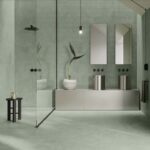Creating a Modern Ergonomic Kitchen
When designing a kitchen, there are several factors to consider, but one of the most important is ergonomics. Ergonomic principles aid in ensuring that tasks such as cooking are carried out in a way that maximises comfort and safety in the kitchen.

GALLERY
This entails customising workspaces, appliances, and kitchen layout to the user’s needs and abilities in order to ensure optimal performance and minimise strain. This Nover whitepaper examines the role of ergonomics in kitchen design and discusses the design considerations when incorporating ergonomic storage solutions.
Effective storage plays a vital role in kitchen ergonomics. Thoughtfully designed storage systems keep the kitchen organised and ensure that essential items are easily accessible, reducing the need for excessive bending, stretching, or lifting. By positioning frequently used items within comfortable reach, well-planned storage enhances the kitchen’s overall flow. This not only promotes a more comfortable cooking environment but also helps maintain a practical, user-friendly space that supports everyday activities.
Importance of Ergonomics in Kitchen Design
Kitchen ergonomics focuses on reducing the physical strain and unnecessary movements that users often face while working. Since working in a kitchen involves a variety of full-body movements—such as bending, reaching, and hand and wrist actions—it is essential to design the space in a way that supports these activities.
Given that the kitchen is one of the most frequently used areas in the home, creating an ergonomic space is key. It is well established that an ergonomic space reduces the risk of musculoskeletal problems resulting from awkward postures and repetitive motions, such as back pain and repetitive strain injuries. Accessibility and kitchen ergonomics go hand in hand.
In addition to improving comfort and productivity, an ergonomically designed kitchen promotes accessibility by making sure that storage spaces, benchtops, and appliances are easily accessible and usable by individuals with varying abilities. Many older Australians (68% of respondents in a recent CareSide survey) report a desire to age in place. As people age, mobility and physical strength may decline, making it essential to create a kitchen environment that minimises strain. By integrating ergonomic principles, a kitchen can be adapted to allow individuals to live independently and safely in their homes for longer.

Features of an Ergonomic Kitchen
Ergonomic kitchen design seeks to create an environment that complements the human body in a practical and healthy way. Below, are some design elements you will typically find in an ergonomic kitchen:
- Kitchen work triangle: Setting up the refrigerator, cooktop and sink in a triangle with a comfortable amount of space between each workspace helps to reduce strain and promotes efficient movement.
- Working surface height: Providing varying benchtop, cooktop and storage to accommodate different tasks and users reduces strain on the back and arms.
- Accessible storage: Providing storage that is easy to use at a comfortable height and with enough capacity to fit all required kitchen items and appliances.
- Proper lighting: Installing general ambient lighting for overall visibility and task lighting to light work areas and lessen eye strain.
- Ergonomic fixtures: Improving usability by utilising fixtures like pull-out sprayers, lever handles, and touchless faucets.
- Ergonomic flooring: Selecting flooring materials that, particularly in wet or spilly environments, offer good traction and lower the chance of slips and falls. Softer flooring materials may also be considered to reduce impact on joints and muscles.
- Clutter-free surfaces: Creating well-organised work areas with plenty of benchtop space and built-in storage options to improve mobility and functionality.

How Ergonomics Apply to Storage Areas
By organising items to ensure everything is within easy reach, smart storage solutions streamline the workflow for tasks like food preparation, cooking, and cleaning. This reduces unnecessary movements and helps make the kitchen a more efficient and comfortable space to work in.
Given the wide range of items found in a kitchen— from utensils and crockery to appliances and cleaning supplies—a well-planned system ensures that frequently used items are readily accessible, while less commonly used items are stored in more appropriate locations.
View the full Nover whitepaper on modern ergonomic kitchens here!
Italian brand Casalgrande Padana has built a reputation as a prolific producer of ceramic and stoneware tiles, translating ...
As kitchens continue to evolve into multifunctional spaces, designers are increasingly seeking appliance solutions that support flexibility without ...
Designing bathrooms remains one of the most complex challenges in residential and commercial projects. Despite often being the smallest ...
Unox Casa is the high-end residential division of UNOX, the world’s top-selling brand of professional ovens, born to ...
Your floors are among the most-used surfaces in your kitchen and living areas and set the tone within ...











